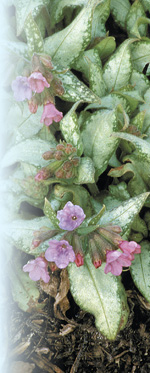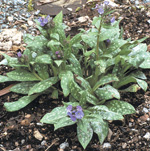Pulmonarias Natural Choice for Shade Gardens
go.ncsu.edu/readext?236047
en Español / em Português
El inglés es el idioma de control de esta página. En la medida en que haya algún conflicto entre la traducción al inglés y la traducción, el inglés prevalece.
Al hacer clic en el enlace de traducción se activa un servicio de traducción gratuito para convertir la página al español. Al igual que con cualquier traducción por Internet, la conversión no es sensible al contexto y puede que no traduzca el texto en su significado original. NC State Extension no garantiza la exactitud del texto traducido. Por favor, tenga en cuenta que algunas aplicaciones y/o servicios pueden no funcionar como se espera cuando se traducen.
Português
Inglês é o idioma de controle desta página. Na medida que haja algum conflito entre o texto original em Inglês e a tradução, o Inglês prevalece.
Ao clicar no link de tradução, um serviço gratuito de tradução será ativado para converter a página para o Português. Como em qualquer tradução pela internet, a conversão não é sensivel ao contexto e pode não ocorrer a tradução para o significado orginal. O serviço de Extensão da Carolina do Norte (NC State Extension) não garante a exatidão do texto traduzido. Por favor, observe que algumas funções ou serviços podem não funcionar como esperado após a tradução.
English
English is the controlling language of this page. To the extent there is any conflict between the English text and the translation, English controls.
Clicking on the translation link activates a free translation service to convert the page to Spanish. As with any Internet translation, the conversion is not context-sensitive and may not translate the text to its original meaning. NC State Extension does not guarantee the accuracy of the translated text. Please note that some applications and/or services may not function as expected when translated.
Collapse ▲
‘Excalibur’
Photo by Robert E. Lyons
Pulmonarias, commonly referred to as lungworts, are quite charming and provide beautiful flowers in the early spring as well as year-round interest with their attractive foliage. Their unusual foliage and flower combinations provide a natural choice for brightening up shade or woodland gardens. The basic green foliage is often edged or speckled with lime green spots or white leaf margins. Add to that a brick-red blossom or a flower that can open out with pink blooms that deepen to a blue and you will have quite a conversation piece in your garden. Cultivars with brick-red blossoms include ‘David Ward’ or ‘Redstart’. For pink blooms that deepen to blue, look for ‘Roy Davidson’. The blooming period is from April through June.
In their native environments, the lungworts grow in a wide range of soils from acid to alkaline, dry to wet, sunny to shady, along streams and in mountains. The cultivated varieties need rich, moist, well-drained soil. They grow best with bright shade and some morning sun. Don’t forget to water them often during dry, hot summers to keep foliage looking fresh. You can mow them off during these periods and new growth will form as the summer cools down. Divide every three to five years and mulch in the fall to protect plants over winter. Spray with a fungicide if you wish to control powdery mildew.

‘Highdown’
Photo by Robert E. Lyons
Twelve pulmonaria species make great groundcovers when grown under ideal conditions. Look for P. saccharata, P. longifolia or P. rubra. Pulmonarias are attractive mixed with ferns, azaleas, rhododendrons, hostas and astilbes or even oak trees and large shrubs.
The JC Raulston Arboretum has kept most of its pulmonaria collection under the shade protection of the lath house that is currently under renovation. This area lessens the harsh impact of Raleigh’s summer sun and heat, enabling visitors to get a good look at these useful herbaceous perennials for shade.
David Barkley


